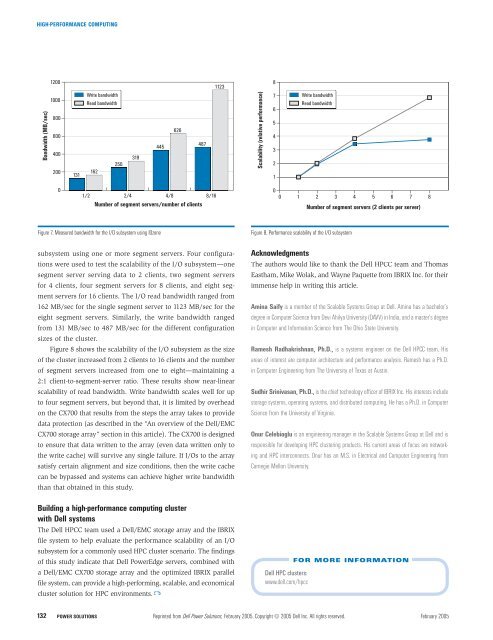Dell Power Solutions
Dell Power Solutions
Dell Power Solutions
- No tags were found...
You also want an ePaper? Increase the reach of your titles
YUMPU automatically turns print PDFs into web optimized ePapers that Google loves.
HIGH-PERFORMANCE COMPUTINGBandwidth (MB/sec)12001000800600400200131Write bandwidthRead bandwidth1622503194456264871123Scalability (relative performance)87654321Write bandwidthRead bandwidth01/2 2/4 4/8 8/16Number of segment servers/number of clients00 1 2 3 4 5 6 7 8Number of segment servers (2 clients per server)Figure 7. Measured bandwidth for the I/O subsystem using IOzonesubsystem using one or more segment servers. Four configurationswere used to test the scalability of the I/O subsystem—onesegment server serving data to 2 clients, two segment serversfor 4 clients, four segment servers for 8 clients, and eight segmentservers for 16 clients. The I/O read bandwidth ranged from162 MB/sec for the single segment server to 1123 MB/sec for theeight segment servers. Similarly, the write bandwidth rangedfrom 131 MB/sec to 487 MB/sec for the different configurationsizes of the cluster.Figure 8 shows the scalability of the I/O subsystem as the sizeof the cluster increased from 2 clients to 16 clients and the numberof segment servers increased from one to eight—maintaining a2:1 client-to-segment-server ratio. These results show near-linearscalability of read bandwidth. Write bandwidth scales well for upto four segment servers, but beyond that, it is limited by overheadon the CX700 that results from the steps the array takes to providedata protection (as described in the “An overview of the <strong>Dell</strong>/EMCCX700 storage array” section in this article). The CX700 is designedto ensure that data written to the array (even data written only tothe write cache) will survive any single failure. If I/Os to the arraysatisfy certain alignment and size conditions, then the write cachecan be bypassed and systems can achieve higher write bandwidththan that obtained in this study.Figure 8. Performance scalability of the I/O subsystemAcknowledgmentsThe authors would like to thank the <strong>Dell</strong> HPCC team and ThomasEastham, Mike Wolak, and Wayne Paquette from IBRIX Inc. for theirimmense help in writing this article.Amina Saify is a member of the Scalable Systems Group at <strong>Dell</strong>. Amina has a bachelor’sdegree in Computer Science from Devi Ahilya University (DAVV) in India, and a master’s degreein Computer and Information Science from The Ohio State University.Ramesh Radhakrishnan, Ph.D., is a systems engineer on the <strong>Dell</strong> HPCC team. Hisareas of interest are computer architecture and performance analysis. Ramesh has a Ph.D.in Computer Engineering from The University of Texas at Austin.Sudhir Srinivasan, Ph.D., is the chief technology officer of IBRIX Inc. His interests includestorage systems, operating systems, and distributed computing. He has a Ph.D. in ComputerScience from the University of Virginia.Onur Celebioglu is an engineering manager in the Scalable Systems Group at <strong>Dell</strong> and isresponsible for developing HPC clustering products. His current areas of focus are networkingand HPC interconnects. Onur has an M.S. in Electrical and Computer Engineering fromCarnegie Mellon University.Building a high-performance computing clusterwith <strong>Dell</strong> systemsThe <strong>Dell</strong> HPCC team used a <strong>Dell</strong>/EMC storage array and the IBRIXfile system to help evaluate the performance scalability of an I/Osubsystem for a commonly used HPC cluster scenario. The findingsof this study indicate that <strong>Dell</strong> <strong>Power</strong>Edge servers, combined witha <strong>Dell</strong>/EMC CX700 storage array and the optimized IBRIX parallelfile system, can provide a high-performing, scalable, and economicalcluster solution for HPC environments.<strong>Dell</strong> HPC clusters:www.dell.com/hpccFOR MORE INFORMATION132POWER SOLUTIONS Reprinted from <strong>Dell</strong> <strong>Power</strong> <strong>Solutions</strong>, February 2005. Copyright © 2005 <strong>Dell</strong> Inc. All rights reserved. February 2005








